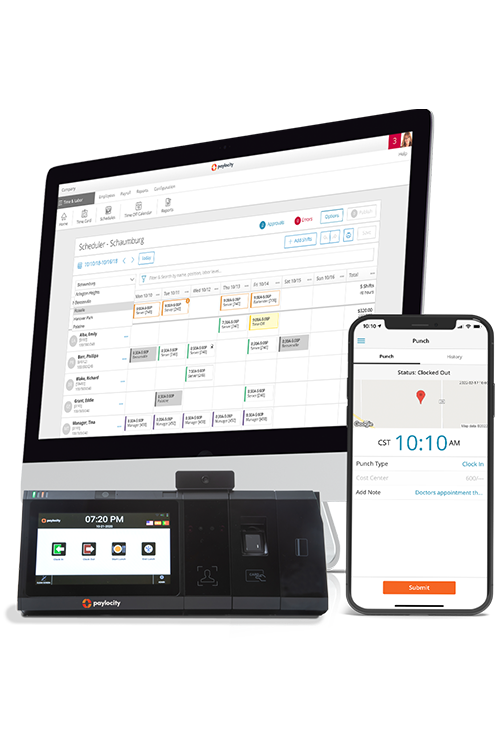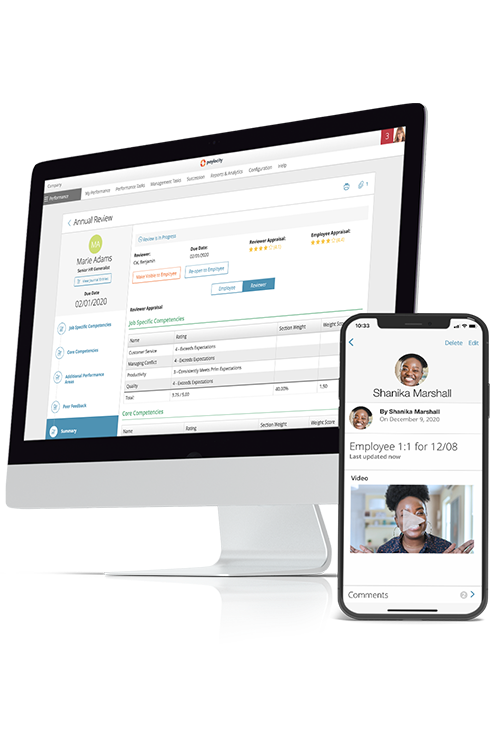Related Learning

Human Capital Strategy: Harness Your People Power
Unlock the potential of human capital strategy, and learn how to craft an effective plan for peak performance and future readiness.
In HR, there are no shortage of metrics, key performance indicators (KPIs), and budgets to juggle. For most, this is the boring part. After all, you work in HR because you love people, not numbers.
Certainly, you know your employees are the most valuable asset — but is your organization truly harnessing their potential?
If the answer to this question isn’t an immediate and unequivocal “yes,” you’ve come to the right place.
In this article, we’ll cover the concept of human capital in business, and how to optimize your human capital strategy for the challenges of tomorrow, today.
What Exactly is Human Capital?
Normally in business, capital means we’re talking about money. So the term "human capital" may sound a bit like turning people into numbers to be computed for finance or accounting.
Don’t worry though: human capital is much more than just attaching a monetary value to your workers.
Human capital is a concept, created by social scientists, that represents the total skills, knowledge, expertise, and potential of your workforce. It also covers their innate abilities and encompasses their health and well-being.
It can be challenging to identify all these intangible assets for every employee. After all, businesses can’t monitor, collect, and analyze human capital in the same way as other assets.
But it does contribute to the overall economic value of your business.
Onboarding, training, education, wellness programs, and other benefits can increase your existing human capital.
When your people can contribute more, your human capital is greater. Logic follows that more human capital means higher productivity, business growth, and increased revenue.
All business assets can depreciate over time, including human capital. A lack of training, employment, and knowledge gaps, or an inability to adopt new technologies and innovate, can all stymie and decrease human capital.
That’s why HR pros must adopt a human capital strategy to protect this critical resource.
What is a Human Capital Strategy?
A human capital strategy is a framework for evaluating and optimizing the value and potential of an organization’s workforce. It involves aligning your resource pool with the vision and goals of the business to minimize skill gaps and maximize future opportunities.
You can follow a strategic planning model to help you advance from discovery to implementation. A well-defined plan is like a football playbook — it helps guide HR departments through all human capital management (HCM) processes at every stage of the game.
A human capital strategy typically includes several components, such as:
- Workforce planning
- Acquisition and development
- Performance management
- Engagement and retention
- Leadership
- Employee health and well-being
- HR solutions and analytics
The Benefits of a Human Capital Strategy
Like an inspiring underdog story, It’s amazing what a team can achieve when everyone is playing to their strengths. Organizations are no different.
Businesses that take an active approach to managing their human capital can expect to gain several benefits:
- Increased engagement. By promoting a positive work environment, you can improve employee health, wellness, and team morale. Additionally, providing opportunities for recognition and growth means greater employee loyalty and retention.
- Enhanced productivity. A human capital approach also optimizes the intangible assets of your team via talent development and recruitment. Simply put, this means your human capital will run like a well-oiled machine (only operated by people).
- Attract and retain top talent. Armed with a battle plan, your recruiters will be able to find and hire the best talent for your business. You can source candidates to fill in any human capital gaps and will likely find a lot of great candidates are attracted to your initiatives (e.g. education and benefits.).
- Gain a competitive advantage. With a human capital strategy, you’re on your way to winning a war of attrition. In competitive markets, every inch you gain makes a difference. Maximizing the potential of your workforce can give you the edge you need to come out on top.
How to Create an Effective HCM Strategy
Okay, let’s talk about HCM strategies, specifically how to create an effective human capital management plan.
1. Define Your Objectives
Every good plan begins with well-defined goals. There are plenty of direct and indirect benefits from human capital planning, but you’ll want to prioritize one to three areas as the primary driver(s) behind your HCM strategy.
Examples of business goals may be to increase employee retention (thus reducing recruitment costs), or to lower labor costs through increased worker productivity.
Remember to follow the SMART framework (specific, measurable, achievable, relevant, and time-bound) when setting these goals.
2. Analyze Your Workforce
Next, perform a workforce analysis of your organization. HR teams should be familiar with this concept as it’s crucial to any workforce planning strategy. It involves performing separate supply, demand, and skill gap analysis.
During these procedures, evaluate multiple areas, including:
- Labor costs. Are yours profitable or excessive?
- Staffing levels. Do you have enough employees for each department and job role?
- Skills. What are you lacking, and are there any areas at risk of a skills shortage in the future?
- Training and development. What courses or qualifications bring the highest ROI? In what areas are your capital lacking the necessary knowledge and skills?
- Soft skills. In what areas are your human capital strong or weak?
- Performance. What characteristics do your top performers share, and where are you failing to perform as strongly as you’d hoped?
After you have a clear understanding of your workforce and its skill sets, you can begin to paint a picture of your total human capital.
Learn More: The Employer’s Guide to Calculating Labor Costs
3. Align HR with Business Goals
After analyzing your workforce, it’s time to look in the mirror and examine your HR strategies. Ideally, all of your current HR initiatives would align perfectly with your defined business strategy.
So, consider how HR processes are helping or hindering organizational goals, such as growth and expansion. How can areas like payroll, recruitment, and development move the business closer to your desired outcomes?
It’s HR’s job to ensure all employees are in support of your human capital strategy. Advocate initiatives that help workers feel heard and supported regarding their professional growth. Moreover, make sure you’re promoting inclusivity in the workplace to boost morale and gain greater buy-in.
4. Invest in Training, Development, and Employee Wellness
Part of aligning human resource management with the rest of the business involves the training and development of your employees. You need to offer your team short, medium, and long-term career plans to keep them engaged (and relevant in their field). These efforts will also help with succession planning.
To help the talent development of your human capital, cultivate an effective learning environment. For example, use a learning management system (LMS) to streamline the onboarding and education of your employees.
Additionally, involve management as front-line promoters for all your development resources. They can also help team members curate development plans through regularly scheduled one-on-ones.
Finally, for maximum optimization, invest in training and extracurricular activities. This might include adding wellness fringe benefits, such as bike-to-work programs, gym memberships, and team-building activities.
5. Develop Talent Acquisition and Retention Strategies
Armed with an in-depth analysis of your workforce, you can better shape your talent acquisition strategy. Prioritize candidates with the characteristics you’ve identified as the most valuable or those that you deem necessary but are in short supply.
You can increase the worth of your human capital by involving your wider team in the recruitment process. For example, make use of collaborative recognition and recruiting software to help you build valuable networks via employee referral programs.
6. Implement Performance Management
Outline clearly defined processes for performance management, such as assessment criteria and review frequency. This will help employees recognize which areas are most valuable to your business.
Use employee self-assessment as another part of your human capital strategy. This can provide employees with better insight into their performance while generating much-needed feedback for management.
Self-assessment gives employees a voice and also provides greater accountability.
7. Use an HR and Data Analytics Solution
Next, you need to track the right HR metrics to assess your HCM strategy.
Use tools like HR admin, talent management, and payroll software to provide analysis and reporting.
These solutions can also automate manual and repetitive tasks, so your team is able to spend more time maximizing your human resources.
8. Monitor and Adjust
Implementing a human capital strategy requires an organization-wide effort. The key is for HR to have the tools and systems in place to continually monitor, measure, and improve this strategy over time. Involve leadership and key stakeholders, and gain regular feedback from all business areas.
From a central HR hub, you can build up and empower your human capital.
Unlock the Full Potential of Your People with a Human Capital Strategy
In the world of business, it’s easy to think about dollar signs and market trends. However, what must never get lost in the sea of constant change are your people assets. With effective human capital strategies, you’ll be well on your way to edging out the competition.
You can unlock the full potential of your team using a solution like Paylocity’s talent management system. This lets you automate recruiting and onboarding, ensure fair pay, and offer opportunities and career development for your entire team.
Armed with the right tools and a carefully constructed plan, you’ll be able to wield a weapon unlike any other — the power of your people.



